Drum Kit Essentials
- A drum kit is made up of three main groups that contribute to its distinctive sound: drums, cymbals, and hardware.
- The snare drum provides the backbeat, the bass drum adds punch, and the toms give melodic depth and movement.
- Cymbals such as the ride, crash, and hi-hat or hats create dynamic contrast.
- Good setup of elements like throne height and pedal tension help drummers play comfortably.
Whether you are a true beginner or an experienced drummers, you will need to know what the main parts of a drum set are. From drums to cymbals, all the different elements contribute to the overall sound, rhythm, and control of your performance.
A standard five-piece kit is a finely tuned system that lets you express music through coordination, timing, and tone. The snare drum delivers a tight snap, the bass drum or kick anchors with a deep thump, and the toms add melodic range and energy. Above the drums sit your cymbals, including the hi-hat, crash cymbal, and ride cymbal. The hardware, or pedals, stands, and drum throne allow the drummer to make adjustments for balance and endurance.
Think of your drum kit as a personal orchestra you command with the sticks in your hand and pedals under your feet. Mastering these common components helps you develop precision, dynamics, and your personal musical style.
In this guide, we will explore every part of the drum set, from bass to crash and snare to ride, so you can understand how each shapes your sound and performance.


Quick Overview of Drum Set Components 🥁
As a beginner drummer, you won’t need to worry about unusual and eclectic drums such as timbales, congo drums or tambourines. You should start out with a basic drum set to learn your craft; you can always expand later on. Let's take a quick look of what you'll find in most 5-piece drum kits.
Snare Drum: Provides the sharp, central backbeat.
Bass Drum: Produces the deep, resonant pulse.
Tom-Toms: Add tone and movement for fills and transitions.
Hi-Hat Cymbals: Control rhythm and texture using foot and stick.
Crash Cymbal: Accents transitions and adds energy.
Ride Cymbal: Maintains steady rhythm and groove.
Pedals: Foot controls for the bass drum and hi-hat.
Stands: Hold cymbals and toms in place.
Drum Throne: Adjustable seat that ensures posture and comfort.
A lot of children start out with a very simple three-piece drum set, comprised of:
- Snare drum
- Bass drum
- Hanging tom
- Hi-hats
- Hanging cymbal
(The “pieces” refer to the drums, not the cymbals).
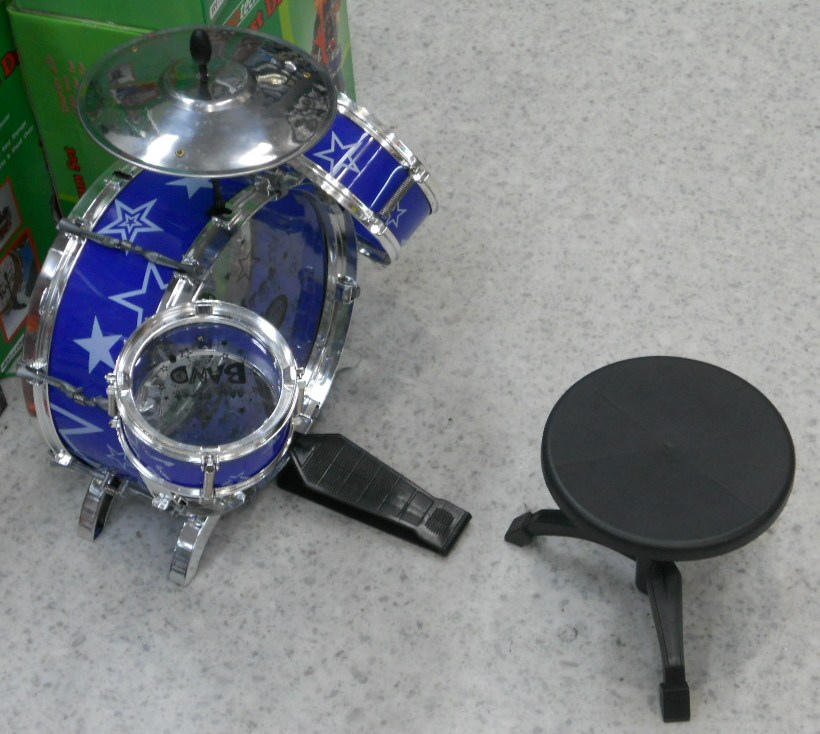
Now learn more facts about drums.
Detailed Breakdown of Drum Set Components
Snare Drum
Snare drums are double-headed drums with wires strung under the lower drum head and tensioned. Also called side drums, snares have drum shells that can be made out of wood, metal, acrylic or fibreglass. Drum skin tension is achieved by the use of tensions rods.

The snare drum is the centerpiece of any drum set, known for its sharp snap sound. Its unique sound comes from the metal wires, or snares, stretched across the bottom head. These vibrate when the top head is struck, creating that familiar crisp tone.
Materials such as maple, birch, or steel influence brightness and warmth, while tuning changes pitch and sensitivity. The snare is often described as the heartbeat of the kit.
You can play the snare with sticks, brushes or mallets.
There are almost infinite variations on the snare drum, from the Highland snare, piccolo snare to the tarol snare.
Also discover the different components that make up a modern drum set!
Bass Drum (kick drum)
Bass drums are generally double-headed. They have a cylindrical body where the diameter is greater than its depth.They come in three main variations: concert bass drums, kick drums, and pitched bass drums. The bass drum is stricken by a heavy felt-covered mallet; two matching mallets or a double-headed mallet is used for drum rolls.
On kick drums, this mallet is attached to the foot pedal.
The bass drum anchors your rhythm and is played with a pedal. It delivers the low-end thump that drives rock, pop, jazz, and funk music.
Smaller bass drums (20″–22″) offer punchier tones, while larger sizes (24″ and above) create deeper resonance. Some drummers use double pedals for rapid, symmetrical bass patterns often heard in metal or fusion styles.
Discover famous drummers of rock and jazz that you could learn from!
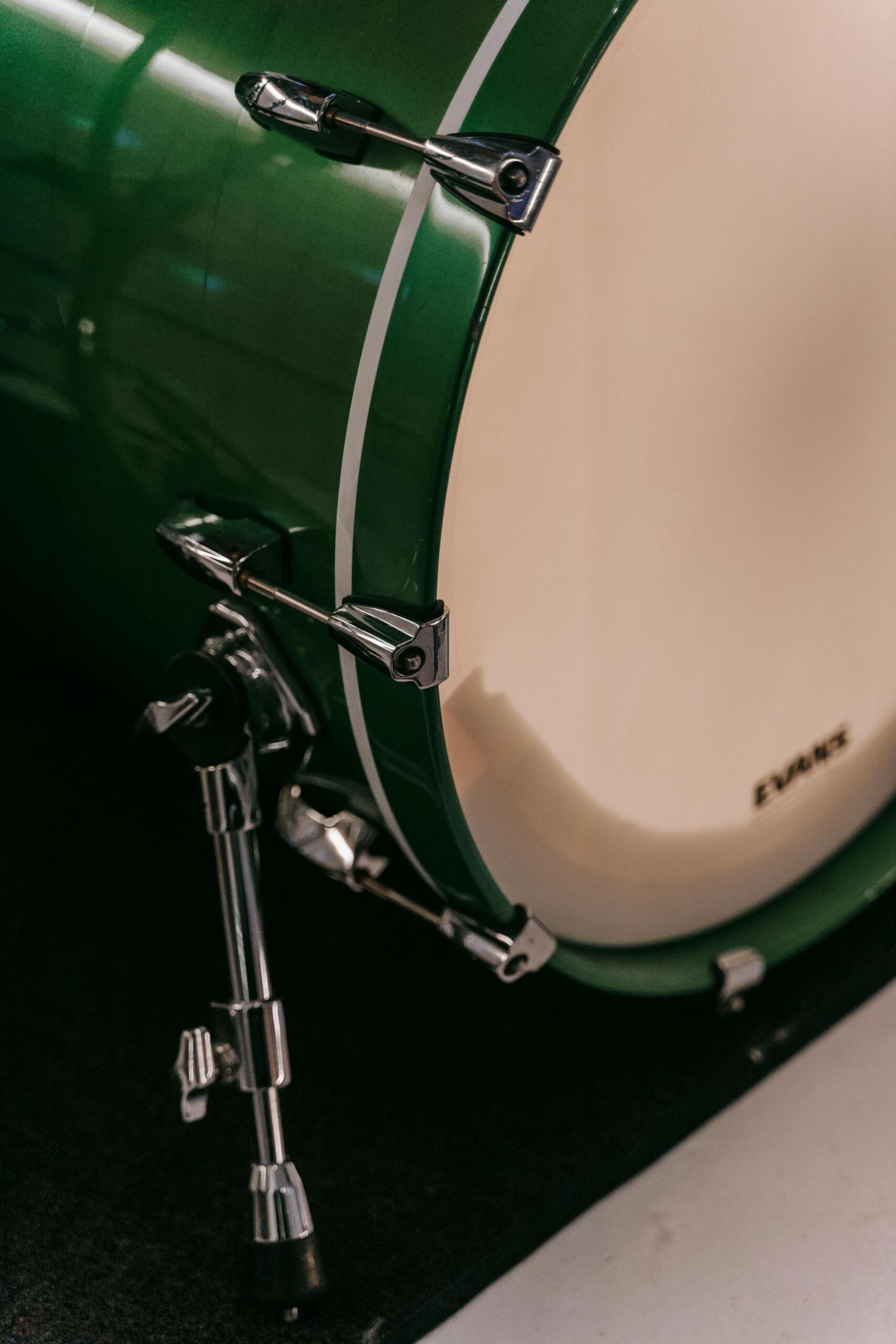
When hung vertically, it might be played with a mallet in one hand and a rute in the other. Bass drums have a deep sound. It is often played on beats one and three, contrasting with the backbeat (two, four) of the other drums.
Tom-Toms
A tom-tom (a term that supposedly comes from India) is a cylindrical drum. Unlike the snare, it has no snare wires; there are one-headed and two-headed variations. Toms are usually used for fills.

The toms add movement and melody. Mounted rack toms sit above the bass drum, while floor toms stand on legs to the drummer’s side.
Their pitch varies by size: smaller toms are higher, larger ones deeper. During fills, rolls, or transitions, they create rhythmic motion and excitement. A five-piece kit usually includes two rack toms and one floor tom, though advanced setups may add more.
The first examples had no rims, but as metal tensioning elements appeared, so did, eventually, the rim. Hanging toms or rack toms are mounted on high stands; racks can take more than one drum. Floor toms are set on short feet. A floor tom is not quite as deep as a bass drum, but more resonant.
Cymbals
A drum set typically has several cymbals; at least two, with any number of additions: hi-hat, crash, ride, and other effect cymbals,
Hi-Hat (Hats)
The hi-hat cymbals are one of the most versatile parts of a drum kit, combining two cymbals mounted on a stand and controlled by a foot pedal. Together, they produce a wide range of sounds, including tight, crisp “chicks” to shimmering open tones.
If the snare is the heartbeat of the drums, the hi-hat is its pulse. Played by both hands and feet, the hi-hat gives drummers control over rhythm, texture, and feel, whether it’s the tight swing of jazz or the sharp precision of pop and rock.
They’re essential for timing: drummers often play eighth-notes or sixteenth-notes on the hat to keep the groove steady. The typical size is 14″, though smaller or larger hats can alter tone and feel.
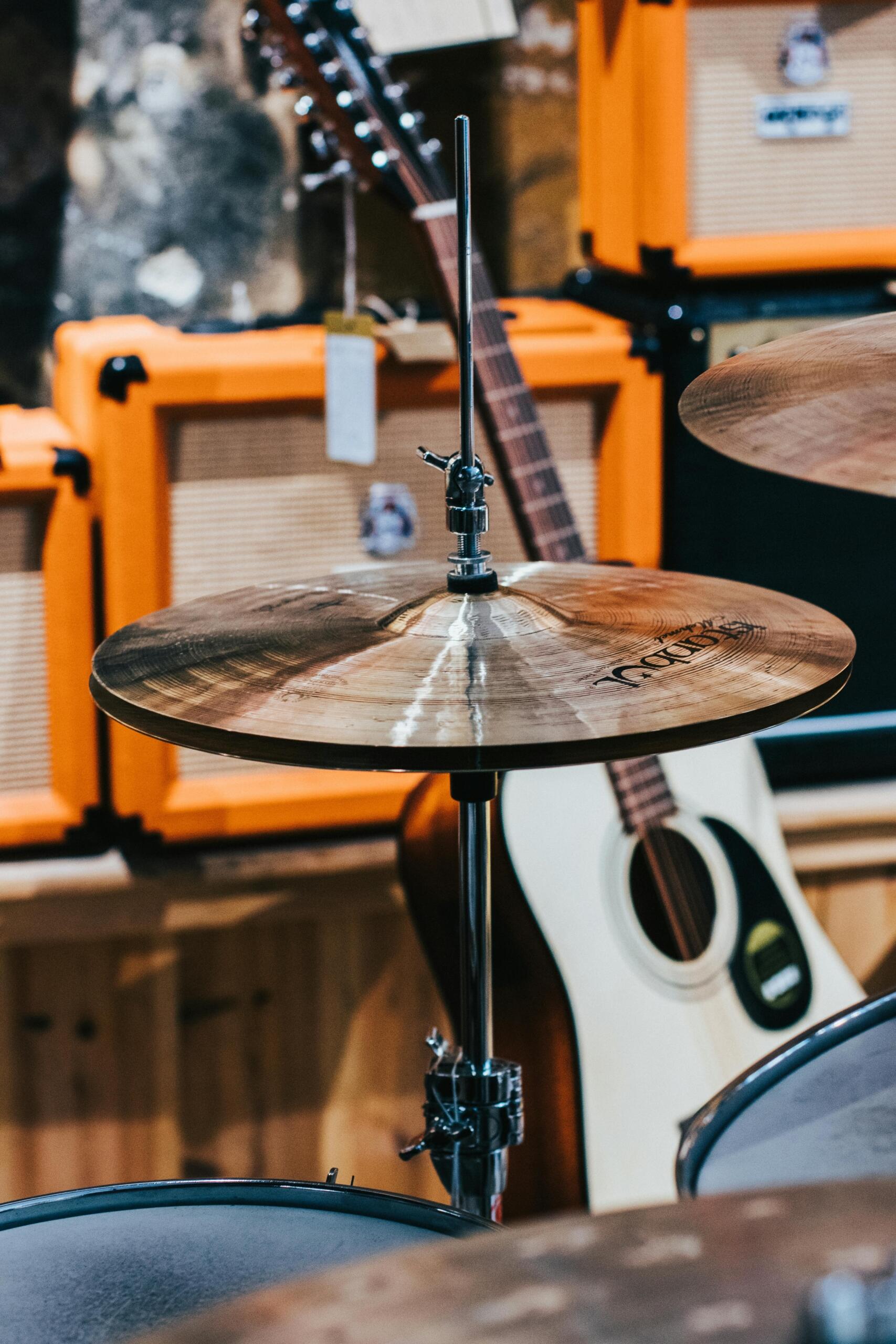
With a quick shimmer or a tight snap, the hi-hat cymbals bring life to every beat. Whether lightly ticking through a ballad or slashing through a rock chorus, the hats add personality and movement to the overall sound of the drum set.
Do you know where the snare fits into the history of drums and drumming?
Crash Cymbal
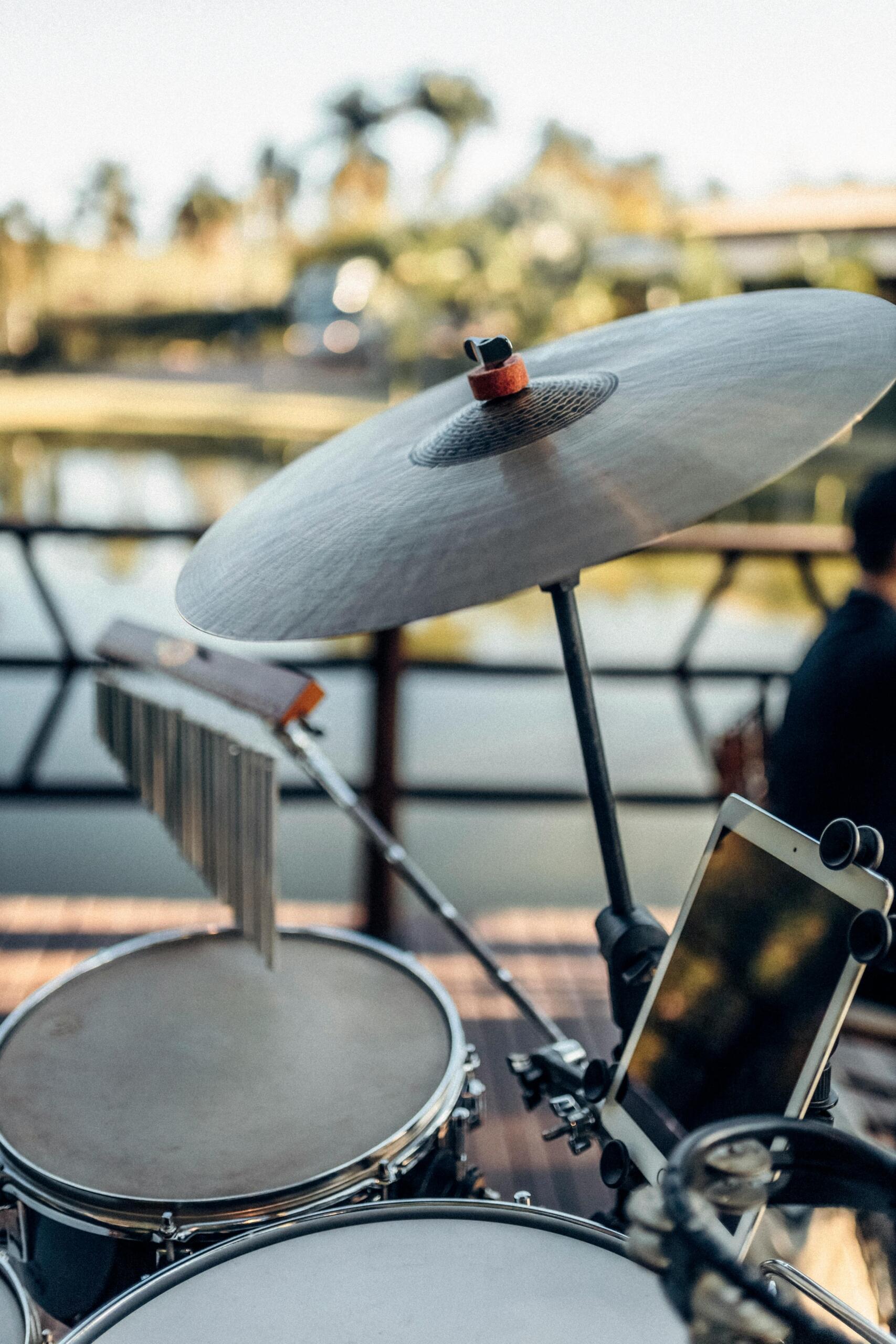
A crash cymbal delivers dramatic accents. Struck forcefully, it produces an explosive sound that marks transitions or climaxes in songs.
Drummers usually position their crash above the left or right rack tom, within easy reach for energetic hits. Common sizes range from 16″ to 18″. Larger crashes ring longer, while smaller ones are brighter and faster.
Ride Cymbal
The ride cymbal is a cornerstone of the drum kit, providing a steady rhythmic foundation that keeps the groove moving. Its broad surface and sustained tone allow drummers to maintain time, add subtle texture, and shape the overall sound of a performance.
The ride cymbal keeps the beat moving. It’s typically larger (20″–22″) and produces a steady “ping” that contrasts with the wash of the crash.
You can play the ride on its bow (main surface) for smooth tones or the bell (center dome) for a more pronounced, metallic accent. In jazz and pop, the ride often replaces the hi-hat for choruses or solos, giving the rhythm more space and flow.
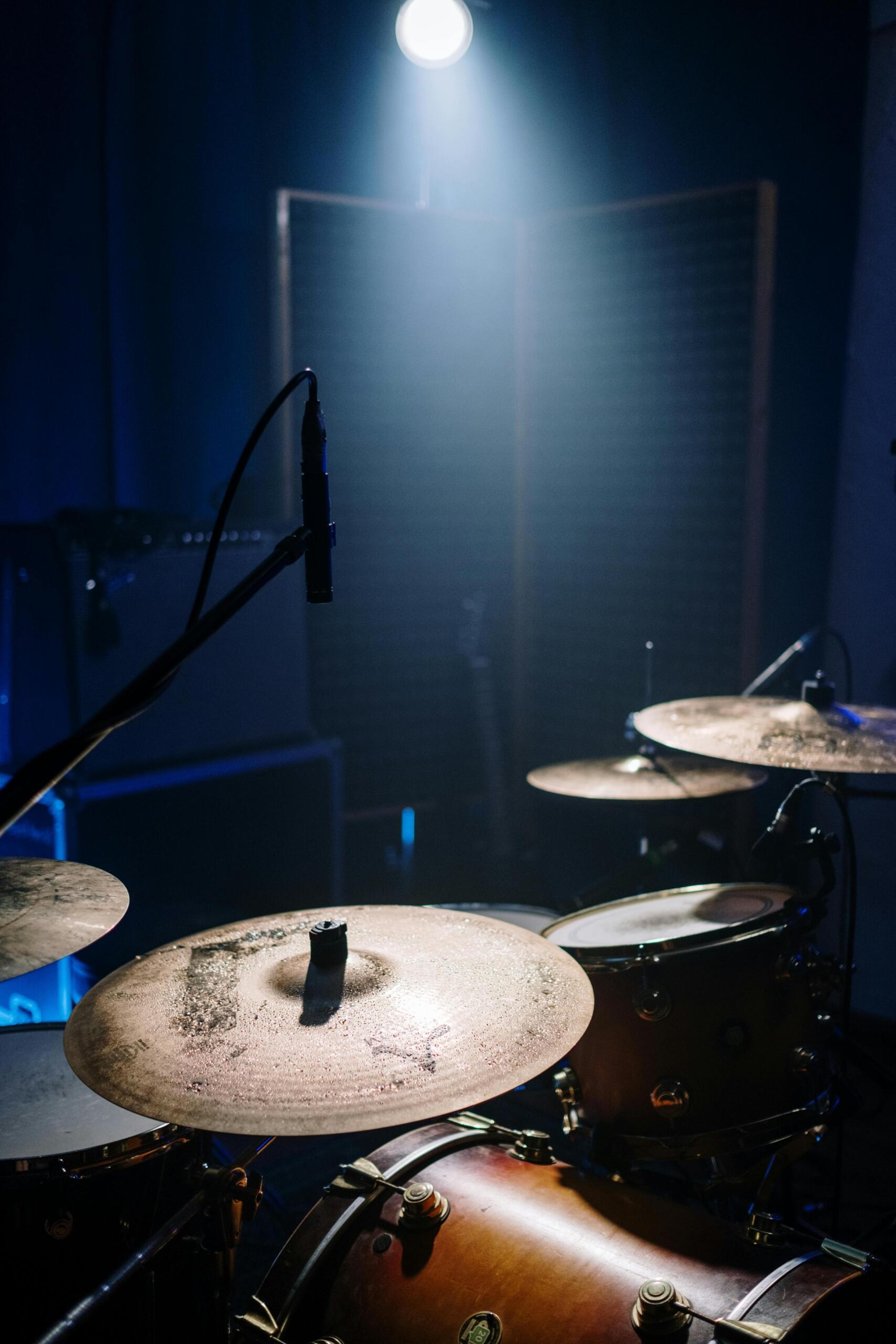
A ride cymbal is typically one of the largest cymbals in a drum set, designed for articulation and control rather than crashes. Its bow and bell areas produce distinct sounds, ranging from smooth rhythmic patterns to sharp, cutting accents.

Hardware
Drum kit hardware forms the backbone of every setup, providing the stands, pedals, and mounts that hold each piece securely in place. From the stability of cymbal stands to the smooth action of bass drum pedals, quality hardware ensures both comfort and consistency for the drummer.
Pedals
Engineered for precision and highly adjustable, drum pedals transform subtle foot movements into powerful, consistent strikes. Whether it’s a single or double bass pedal, drummers rely on smooth action, spring tension, and beater control to achieve speed, balance, and responsiveness during performance.
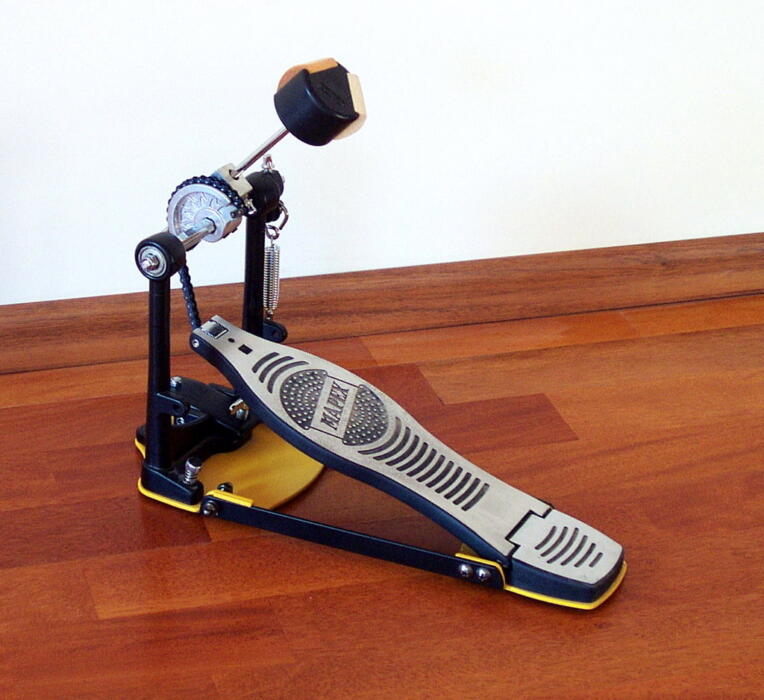
Your pedals are what connect your feet to your drum kit. The bass drum pedal powers your groove, while the hi-hat pedal opens and closes the hats.
Modern drummers fine-tune pedal tension and spring strength to match their style. Double bass pedals allow two-foot coordination, essential for metal, progressive, and fusion genres.
The pedals are where rhythm meets control. They let drummers feel every pulse—pressing down for the deep thud of the bass drum or gently tapping to open the hi-hats. Well-tuned pedals make a kit feel alive, responding instantly to the drummer’s groove and style.
Check for popular drum lessons Edmonton here.
Drum Stands
High-quality stands ensure your cymbals, toms, and snare drum stay secure. Look for adjustable height, memory locks, and double-braced legs for durability. Ergonomic placement reduces fatigue and improves reach for long sessions.
Here is a place you can take drum lessons Vancouver.
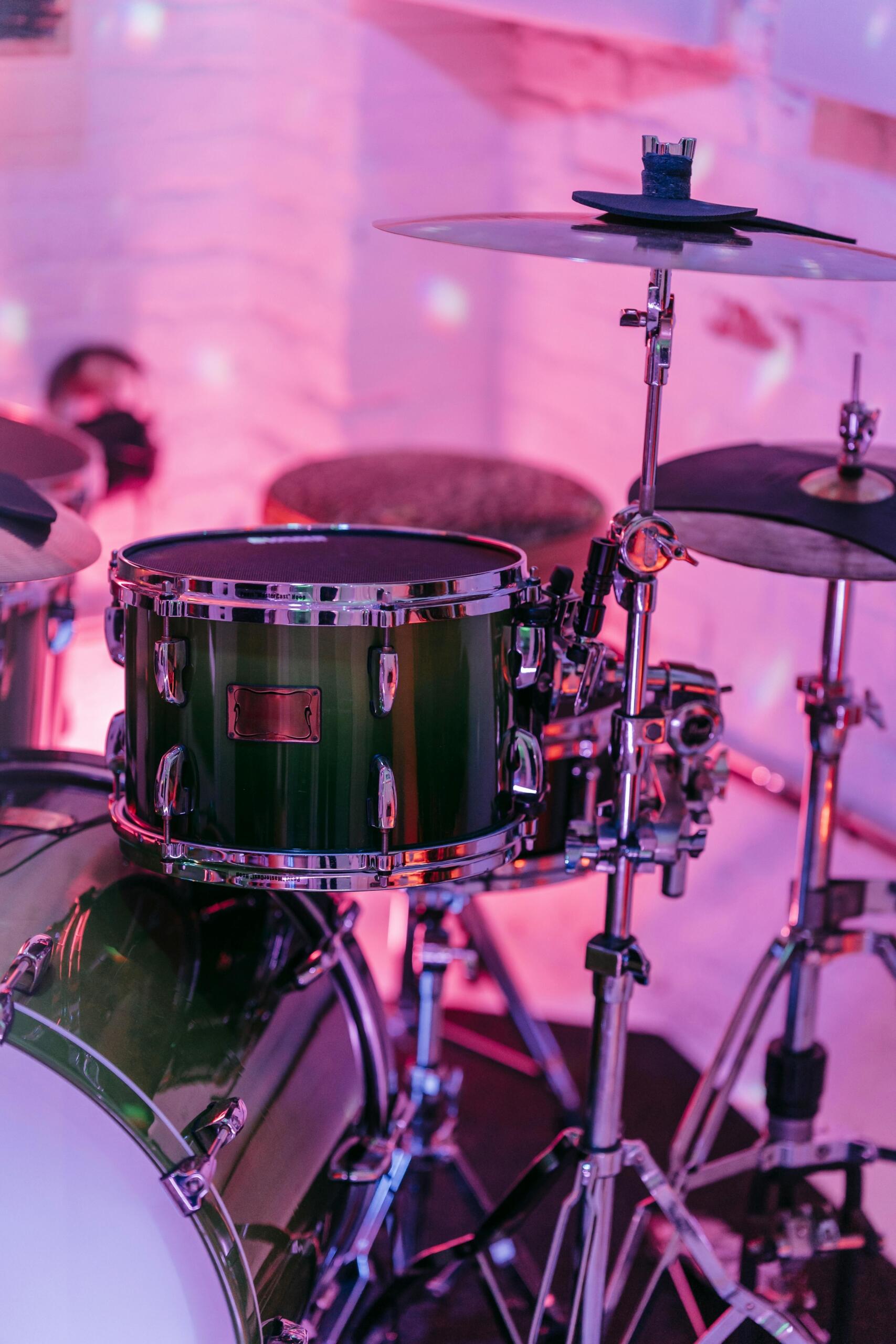
Drum Throne
Drum stands are the sturdy foundation of any drum kit, designed to hold the snare, toms, and cymbals securely in place. Adjustable and durable, they allow drummers to position each element comfortably for balance, reach, and optimal sound during play.
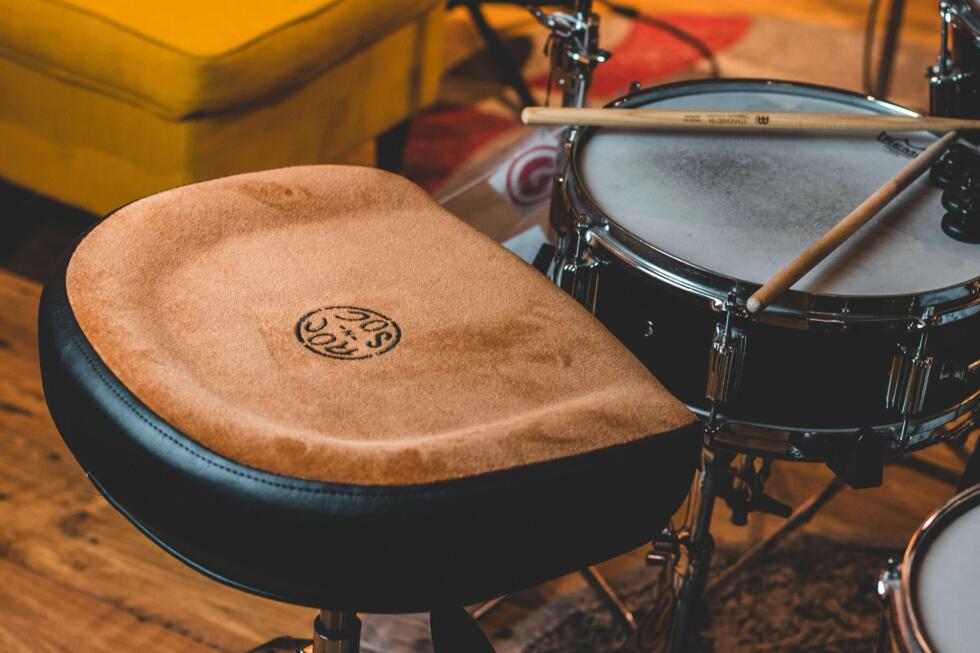
Never underestimate your seat! The drum throne supports posture, stability, and endurance. Adjustable height ensures your thighs angle slightly downward, letting you control pedals with precision. A comfortable throne helps you maintain balance and play longer without strain.
What easy drum pieces can beginners learn to play the drum to?

Additional Components and Accessories
Drummers today often personalize their kits with extra percussion or tech upgrades:
- Cowbells or tambourines mounted on hats for added texture.
- Splash cymbals and china cymbals for more accent variety.
- Electronic pads that trigger digital sounds or samples.
- Hybrid drum kits that mix acoustic and electronic elements for maximum versatility.
Unless your family, neighbors, or roommates love hearing the sound of the drums in their personal space, you might want to consider alternatives. Electronic and hybrid kits are perfect for quiet practice or home recording, offering headphone monitoring and customizable sounds.
In the course of your drum lesson, your Superprof drum instructor may recommend such a kit!
Setting Up your Drum Kit
Ergonomics & Positioning
Your drum set should feel natural—everything within comfortable reach.
- Start by adjusting your drum throne so your knees are slightly below your hips.
- Place the bass drum directly ahead, with the pedal flat and stable.
- Position the snare drum level with your waist.
- Mount your toms to follow a natural stick arc from snare to floor tom.
- Keep cymbals angled slightly toward you to prevent edge damage.
Maintenance Tips
- Tune regularly: A well-tuned snare drum and toms produce cleaner tone and better response.
- Clean cymbals: Use non-abrasive polish to maintain brightness.
- Tighten hardware: Check wingnuts, clamps, and pedals often.
- Protect your kit: Use cases and store your drum set in a dry, temperature-controlled space.
If you take drumming and drumming lessons seriously you will eventually want to invest in a five-piece kit or another drum set.
What are Electronic Drum Sets?

Electronic sets have the advantage of full volume control - you can get the energy of hitting hard without blowing away the ears of little old ladies intent on their afternoon tea. You can even listen to them with headphones.
They include:
- A drum module that processes the data and turns it into sound.
- Drum pads with trigger pads that can be programmed to the sound you want. This is not necessarily a version of acoustic drums, but can be any sound you want. Rhythmic squeaking mouse is seldom called for, but it is possible on an electronic drum. They are usually organised the way the drums would be on an acoustic drum rack.
- Rubber cymbals.
Electronic drums are particularly useful if you want absolute control over the volume of your drums or if you want to reproduce a sound that cannot be made by other modern instruments.
However, tapping the trigger pads does not have exactly the same feel as drumming on acoustic drums. You will be lacking feedback from your sticks. It is possible to attach specially-made trigger pads to a traditional drum set for a hybrid drumming experience.
What is the History of the Drum Kit?
Originally, in classical orchestras, drummers specialised in one type of percussion instrument. You played the timpani (kettle drums), or snare drums or concert toms. This was in part because different composers used different percussion for each of their scores. So drummers and percussionists were hired as needed - and you might need three or four different percussionists for one piece.
A good groove releases adrenaline in your body. You feel uplifted, you feel centered, you feel calm, you feel powerful. You feel that energy. That's what good drumming is all about.
Mickey Hart, Drummer, The Grateful Dead
Experiments with foot pedals in the 1820s opened up the possibility of playing two instruments at the same time. The first drum sets appeared around the 1860s. Music-hall music and the emergence of popular music venues made conductors all the more eager to cut down on the number of musicians they have to pay. Anyone capable of playing several instruments at once was a welcome addition.
This was generally a bass drum, a snare drum and cymbal, played with hand-held drumsticks. But the invention of the “low-boy” pedal for cymbals led to a technique called “double-drumming”. In it, the bass drum was played on beats one and three while the snare drum was played on the other beats - and for the first time, the cymbals could be played simultaneously.
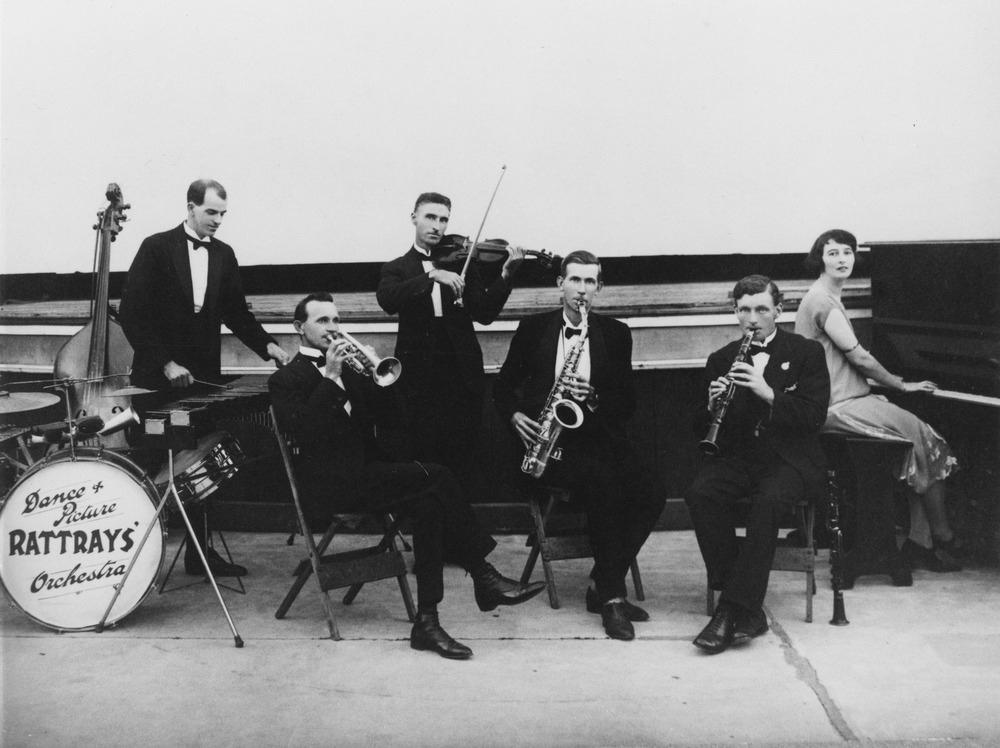
The first drum kits
The drum set was originally called a trap set; drummers using it were called trap drummers. While the overhang pedal for the bass drum was known since the 1870s, it was not immediately popular, many drummers preferring to continue in the double-drumming style. As more and more companies offered solutions for a drum pedal, the bass drum became the kick drum, liberating the hands for more complicated fills and drum rolls with the snares.
These pedals were often rather slow or unreliable in their timing until the Ludwig & Ludwig Co. patented the first truly reliable bass drum pedal in 1909. Now nothing stood in the way of the full potential of the kick drum.
Very often, early trap sets were set up by each individual drummer, and while the combination of instruments - snare and bass - was fairly common, stands or traps could hold any combination of toms, gongs, tambourines… and, in fact, still can.
The basic modern drum kit, though, arose in the 1920s vaudeville bands. Baby Dodds, a drummer playing riverboats on the Mississippi with Louis Armstrong, hung a side cymbal over the bass drum - the first ride cymbal. The Ludwig Company invented a lower version of the hi-hat after observing Dodds tapping with his left foot; Dodds then suggested it be raised so it could be easier to play.
And so one man had a hand in the invention of both signature drum-set cymbals.
Big-Band Era drum sets

With a new sound becoming popular in the 1930s - due in part to the popularity of radio - a new drum sound was needed, and drum kits expanded to include not only the snare and bass drums, but also tom-tom drums; a China cymbal and small crash cymbals became popular additions. But the basic big band drum set soon became established as:
- Bass drum
- Snare drum
- Tom-tom
- Floor tom
- Hi-hats in various iterations
Eventually, the large floor toms got fitted with legs, and “consolettes” made it possible to add smaller drums (usually tom-toms called “ride toms”) above the bass drum.
As be-bop evolved, the trend led away from the big drums toward a sound that wasn’t quite as loud. Mostly this meant smaller drum sizes and the popularisation of the ride cymbal. Be-bop bands also pioneered the use of a double bass drum.
References
- “Beginner’s Guide to Types of Drums” , School of Rock. https://www.schoolofrock.com/resources/drums/beginners-guide-to-types-of-drums
- “The History of the Drum Kit”, KEF Music Blog. https://ca.kef.com/blogs/news/the-history-of-the-drum-kit
















hi, my son is turning 2 next month so I was thinking on getting him a drum set. i know he still is very small but he is very good at it. I will play him videos and i know he is learning because he plays on the plastic drum set. which drum set should i get for him?? thank you